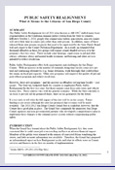|
AB109 • Proposition 47 • Proposition 57 Since the turn of the century, progressive politicians and civil liberties groups have demanded an end to increased sentences for repeat offenders to reduce what they feel is “over-incarceration” and racial disparities. In California these demands have resulted in 12 years of unprecedented reforms to its criminal justice system. AB 109— Public Safety RealignmentIn April 2011, four months after Governor Jerry Brown took office, he signed AB109 into law. The Public Safety Realignment law (which passed without hearings on a straight party-line vote) made most property and drug felons ineligible for state prison sentences. The law instead required that these thousands of felons serve their sentences in county jails. It also eliminated the tough state parole supervision for most felons released from prison, requiring instead that they be placed on less intensive county probation. Since Realignment’s adoption, property and violent crimes have increased throughout California. Counties have been struggling to deal with overcrowded jails and repeat felons on probation. Sheriffs have been forced to address increased drug abuse and violence in county jails—noting that Realignment’s move of more felons and gang members into their jails has created a prison-type environment. It took about two years before the offenders in this category upped their game to car jacking, burglary, armed robbery, and assault, some of which still carried prison sentences. Proposition 47— The Safe Neighborhoods and Schools ActWhile the state prison population began to rise, progressive billionaire George Soros and the ACLU financed Prop. 47, the Safe Neighborhoods and Schools Act. This measure, adopted in 2014, downgraded more crimes, including thefts of $950 or less, into misdemeanors. As a result of more car thieves, wife beaters, child molesters, and gang affiliated drug dealers filling the overcrowded jails, many were being released having served only a fraction of their sentences. Proposition 57— The Public Safety and Rehabilitation ActIn 2016, Governor Jerry Brown and George Soros put Prop. 57 on California’s November Ballot. The Public Safety and Rehabilitation Act, billed as providing nonviolent offenders a chance for early release and rehabilitation, passed despite warnings from district attorneys and sheriffs that the measure would allow habitual felons with priors for rape and murder to gain release. The Governor denied this, but in 2017 a Los Angeles appellate court and a Sacramento judge both ruled that the warnings were correct. Prop. 57 also gave the Governor’s political appointees running the state prison system (California Department of Corrections & Rehabilitation) the unfettered authority to award good behavior credits to inmates, allowing serious and violent criminals to be released after serving one-half to two-thirds of their sentences with no public oversight. In 2020, as the pandemic hit, pro-criminal politicians used emergency regulations supposedly to advance sentencing reforms. Governor Gavin Newsom released an estimated 10,000 inmates from prison, and local officials released an unknown number of offenders from jails, to protect them from infection of COVID-19. Bail was essentially abolished. This left hard core offenders on the streets in May of 2020 to join the George Floyd protesters and commit crimes with impunity. Violent and property crimes have been increasing at an alarming rate ever since, while liberal groups have issued studies utilizing overall crime data during the rollout of Realignment, Prop. 47, and Prop. 57, to offset the striking increases in murder and aggravated assault with the drop in reported property crime. Police explain that the public has stopped reporting most property crimes, with the exception of stolen cars, because the officers no longer show up and, even if thieves are caught there are no consequences. |
| connect:
|





